[ Plant
part | Family | Aroma
| Constituents | Origin
| Discussion |
- Synonyms
| pharm |
Fructus Capsici |
| Danish
|
Paprika |
| Dutch |
Paprika |
| English
|
Bell pepper, Pod pepper,
Sweet pepper |
| Esperanto
|
Papriko |
| Estonian
|
Harilik paprika |
| Finnish
|
Ruokapaprika, Paprika |
| French
|
Piment annuel, Piment doux,
Paprica de Hongrie, Piment doux d'Espagne |
| German
|
Paprika |
| Greek |
Pipería |
| Hindi |
Deghi mirch |
| Hungarian
|
Paprika, Édes paprika,
Piros paprika, Fűszerpaprika |
| Icelandic
|
Paprikuduft |
| Italian
|
Peperone, Paprica |
| Papiamento
|
Promenton, Promčntňn |
| Portuguese
|
Pimentăo doce |
| Polish
|
Papryka roczna |
| Romanian
|
Ardei |
| Spanish
|
Paprika, Pimiento dulce,
Pimiento morrón, Pimentón |
| Swahili
|
Pilipili hoho |
| Swedish
|
Paprika |
| Tibetan
|
Sipen ngonpo, Si pan sngon
po |
- Mexican chile cultivars
- A large number of names for different cultivars is used
in Latin America, especially México. Fresh and dried
chiles are often referred to by different names. The
following table lists some of the most common types.
| Name fresh |
Name dried |
Pungency |
| Anaheim
(California) |
chile pasado |
low |
| Chilaca |
pasilla (chile
negro) |
low |
| Jalapeńo |
mora (morito)
chipotle (chile ahumudo, chile meco) |
medium |
| New Mexico |
chile pasado |
low |
| Poblano |
mulato ancho |
low |
| Serrano |
|
high |
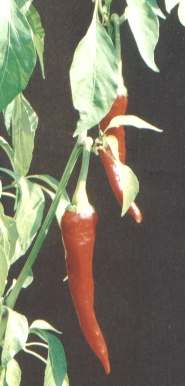
|
| A European breed of paprika |
- Used plant part
- Berry fruits. Removal of seeds and veins results in a
less pungent and more brightly coloured product.
- Plant family
- Solanaceae (nightshade family).
- Sensoric quality
- Sweet and aromatic. Some qualities show no pungency at
all, others are fairly hot.
- Main constituents
- The pungent principle, capsaicin, is contained only in
small amounts, as low as 0.001 to 0.005% in
"mild" and 0.1% in "hot" cultivars.
(see chiles for details on capsaicin). Apart from
capsaicin, the taste of paprika is mostly due to
essential oil (<1%; with long-chain aliphatic
hydrocarbons, fatty acids and their methyl esters);
paprika scent is mostly do to a range of
alkylmethoxypyrazines (e.g., 3-isobutyl 2-methoxy
pyrazine, "earthy" flavour). Ripe paprika
contain up to 6% sugar.
Furthermore, paprika contains
sizable amounts (0.1%) of vitamin C; this substance was
first isolated from ripe paprika pods by the Hungarian
chemist Albert Szent-György, who later won the Nobel
Prize for this work.
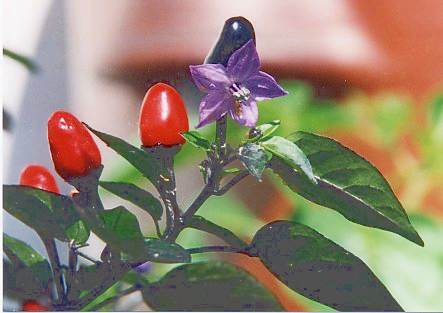
|
| Black Prince, an ornamental
breed rich in anthocyanin pigments (tepín-
or piquín type). |
Paprikas derive their colour from red
(capsanthrine, capsorubin and more) and yellow
(cucubitene) carotenoids ; their total amount in dried
paprika is 0.1 to 0.5%. Cultivars lacking the red
pigments appear yellow or orange when ripe. Some
varieties of paprika contain pigments of anthocyanin type
and develop dark purple, aubergine-coloured or almost
black pods; in the last stage of ripening, however, the
anthocyanins get decomposed, and the unusual darkness
thus gives way to normal orange or red colours.
- Origin
- Since different varieties of bell peppers have been
cultivated in America long before the arrival of the
Europeans, their native countries cannot be unambiguously
determined; South American origin is, however,
established for all species of genus Capsicum,
which emerged probably in the area bordering Southern
Brazil and Bolivia. Thence, the species moved to the
North, being dispersed by birds.
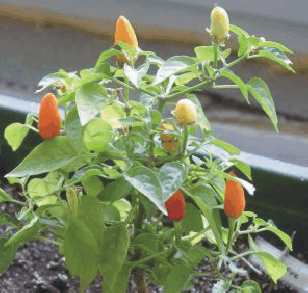
|
| Prairiefire, an ornamental of
piquin type. |
The three species C. annuum, C. frutescens
and C. chinense evolved from a common ancestor
which was located in the North of the Amazonas basin
(NW-Brazil, Columbia). Further evolution brought C.
annuum and C. frutescens to Central America,
where they were finally domesticated (in México and
Panamá, respectively), whereas C. chinense moved
to the West and was first
put to cultivation in Peru; (although
today it is not much cultivated in South America). Two
other species were first cultivated in Western South
America: C. baccatum in the Peruvian lowlands and C.
pubescens at higher elevations, in the Andes (Peru,
Bolivia, Ecuador). See chile for more information about
these species.
As paprika plants tolerate nearly every climate, the
fruits are produced all over the world. A fairly warm
climate is, however, necessary for a strong aroma;
therefore, in Europe, Hungarian paprika has best
reputation; the best comes from the Kalocsa region. In
the Unites States, California and Texas are the main
producers.
- Etymology
- In many European languages, the name of this spice is
somehow derived from the name of pepper, owing to the
many confusions of pepper with other spices (for another
example, see allspice).
So, in English it is called bell
(or pod) pepper (because of shape) or sweet
pepper (because of taste; cf. French piment doux
or Spanish pimiento dulce); most confusingly, the
English plural peppers always seem to imply
paprika and never pepper!
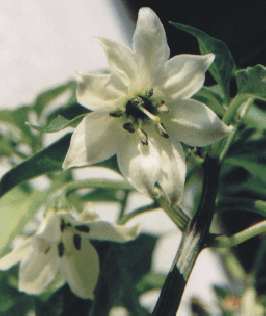
|
| Flower of C. annuum |
For reasons of clarity, the term pepper for Capsicum
species will be totally avoided here. Instead, I will use
paprika, which is moderately common in English
(for the dried spice), more so in other tongues; it was
loaned from Serbian pŕprika or Hungarian paprika
(both Serbian and Hungarian cuisine make much use of
middle-hot Capsicum powder). Ultimately, also paprika
derives from the name of pepper (Serbian pŕpapr).
The botanical species name Capsicum is a
neo-Latin derivation of Greek kápsa "box,
capsule" and the refers to the shape of the fruits.
There is an alternative, though much less probable,
derivation starting from a related verb, káptein,
translated "bite". The verb's basic meaning,
however, is "seize, grasp"; it may also mean
"grab using the teeth; bite", but even from
this meaning it's a wide sematic shift to
"biting" in the sense of "pungent".
The old German name Beißbeere "biting
berry" for hot chiles is probably a loan
translation.
The genus name annuum means "annual"
(Latin annus "year"). This name was
chosen most unfortunately, because in the absence of
winter frosts, paprika and its relatives can survive
several seasons. In its natural habitat, paprika grows
into large perennial shrubs.
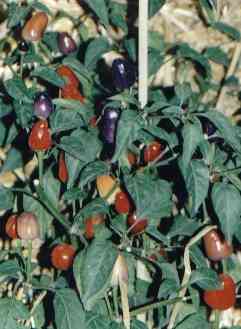
|
| Chinese five-coloured paprika cultivar.
|
The bright red colour of ground paprika is
a remaining impression for everyone who has had an opportunity to
visit a market in the Near or Middle East (from Morocco via
Turkey to Northern India). In these regions, the spice is equally
valued for taste as for colour. Its subtle, sweet flavour is
compatible with hot and spicy dishes, but also mild stews profit
greatly from it. Since paprika contains significant amounts of
sugar, it must not be overheated, otherwise the sugar turns
bitter. Frying paprika powder in hot oil is therefore critical
and must last no longer than a few seconds.
A spice mixture from Central Asia employing paprika is baharat,
a fiery composition from the countries around the Gulf of Persia.
As many other mixtures from Arabic-influenced cuisines (see
grains of paradise on Tunisian gâlat dagga, cubeb pepper
on Moroccan ras el hanout and long pepper on Ethiopian berebere),
baharat contains both pungent and aromatic spices: black
pepper, chiles and paprika provide a pungent background and
nutmeg, cloves, cinnamon and cardamom contribute aromatic
flavour; the mixture furthermore contains cumin and coriander
fruits, all of which are ground to a fine powder. Baharat
is mainly used for mutton dishes; most commonly, the mixture is
shortly fried in oil or clarified butter to intensify the
fragrance.
In Europe, especially Hungary and the Balkan countries are
known for much paprika consumption, less so the Mediterranean
countries, although some Spanish cultivars are famed (e.g., romesco).
Even in those countries where hot chiles are disliked, mild
paprika types are valued as spice and especially popular for
stewed or barbecued meat and sausages. Paprika appears very
frequently in commercial spice mixtures.
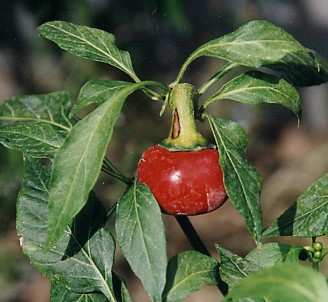
|
| Hungarian cherry paprika (cseresznyepaprika)
|
It is not fully clear how the paprika arrived in Hungary, but
there is no doubt that the fruits were brought by the Turks in
the 17.th century, who might have encountered them before in
Portuguese settlements in Central Asia. Anyway, paprika became
quickly naturalized and have since proved an important flavour in
Hungarian cuisine. Still, some of the best paprika cultivars in
Europe are found in Hungary. An example is the cherry paprika
("cherry pepper", cseresznyepaprika), which has
medium pungency (well, enough for most Europeans) but an
excellent flavour. This is one of the few non-American paprika
cultivars that can rival with Mesoamerican, particularily
Mexican, varieties. Cherry paprika can be dried and ground to a
rather piquant paprika powder, but in Hungary it is also eaten
fresh and served as a kind of table condiment. Lastly, it is very
good pickled.
In Hungarian cuisine, different grades of paprika of varying
pungency are used. There are four basic grades: különleges
(special paprika), csemege (delicatesse paprika), édesnemes
(sweet and noble paprika) und rózsa (rose paprika). Other
than in México, these grades do not stemm from distinct paprika
cultivars; the differences entirely come from the degree of
ripeness at harvest time and selection of pods by size; a chief
point accounting for the differences in pungency, colour and
flavour is the proportion of mesocarp (fruit wall), placenta and
seeds which are ground together. Különleges consists
only of selected mesocarps of fully ripe harvested, flawless
paprika fruits; it has a mild, delicate flavour, no pungency and
a bright red colour. In the more common grade csemege, the
paprika flavour is stronger, but it is still almost non-pungent. Édes-nemes
has a subtle pungency, and rózsa is a piquant product
with still good paprika flavour, but markedly reduced colour; for
its production, the fruits may be plucked in a partially riped
state and be subject to an artificial ripening process. Rózsa
is the grade most often available in other countries.
To produce the milder grades, one needs much mesocarp, but
only little veins, placenta and seeds. The excess material is
then ground to yield a hot paprika powder (cípôs) of
orange-brown colour and poor flavour; it is almost as pungent as
common chile powders, e.g., cayenne pepper. In some literature,
additional grades between rózsa and cípôs are
mentioned (gulyás, erôs).
The Hungarian "national dish" is gulyás,
which basically means "cattleman", and is also used to
name the cattleman's favourite food: a thick and spicy soup made
from beef, varying vegetables (potatoes, carrots) and a
particular type of pasta. To get the right flavour and colour,
chopped onions are lightly fried in pig's lard; when the onions
take a pale yellow colour, paprika powder is stirred in and fried
for a few more seconds before the remaining ingredients are
added. It is the art of goulash making to fry the paprika powder
as long as possible (to bring out its flavour), but stop the
frying before it turns bitter (which may happen very quickly).
This food has been much copied but also bastardized in the
cooking of other European countries; the
"internationalized" versions (goulash) are often stews,
not soups, made of beef or pork in a thick sauce made from onions
and paprika powder. In Austria, often caraway is used for the
seasoning. In Hungary, such a dish would be not be called a gulyás
but a pörkölt; a pörkölt with sour cream added
is a paprikás. Another well-known Hungarian food is lecsó,
a tasty stew from nonpungent capsicum vegetable, tomatoes, onions
and sometimes smoked bacon. Lecsó is flavoured with hot
paprika.
Nunpungent paprika grown as a vegetable (often called bell
pepper in English, although they aren't peppery at all) are an
Eastern European invention, probably from Bulgaria. They arose
quite lately, at the end of the 19.th century, and have become a
popular food all over the world since then.
Although chile and paprika do not stem from Central America,
the art of their cultivation has reached its highest peak in
México. In México, the species Capsicum annuum is grown
almost exclusively; it is unique among all Capsicum
species because there are both pungent and mild cultivars. See
chile for a discussion of the other species.

|
| Chile tepín, flower and ripe
fruit |
It is often speculated that the variety called tepín
or chiltepín (chilctepín, "flea chile",
C. annuum var. aviculare or C. annuum var. glabrisculum),
which grows wild in the North Mexican desert (Sonora) and also in
parts of the US (Texas), might have been put to cultivation by an
ancient Mexican people and has, thus, become the actual ancestor
of all cultivated C. annuum varieties. By this line of
reasoning, the chiltepín would be the ancestor of most of
today's chile and paprika cultivars grown on all continents with
the sole exception of Southern America, where still today
botanically different species dominate (see chile for details).
It is, however, difficult to explain (i) how the chiltepín
could have travelled from its diversification locus (Amazonas
basin) that far into the North without human help, and (ii) why
all early records of chile cultivation point to Central and
Southern México, never to the North. So the chiltepín is
more probably a cultivar that has escaped back into the wild, not
an original wild form.
The chiltepín is quite hot and can be fiercingly hot;
it is much used for North Mexican cuisine and has quite recently
established itself on the US market, fuelled by the large number
of Mexican immigrants and the general interest in Mexican and
other spicy food. It should be noticed that the tepín is still a
wild plant, and all of the crop is collected from the wild. So
far, all cultivation attempts have failed.
In México, there exists a continous spectrum of paprika pods,
from the very mild to the very hot. Confusingly, all of them are
usually referred to as chiles, and indeed they are all one
botanical species. To keep things more compatible with other
countries (where there is just hot chile and mild paprika, but
nothing in between), I will not use the term chile for mild
varieties, but stick to the name paprika for all mild to
medium hot Mexican chiles.

|
Chiltepín
pods
|
|
|
|
|
|
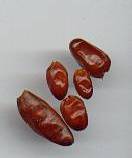
|
Dried chile
piquin
|
|
Mexican chiles and paprika are known and identified by their
local names. The smallest of these are just one or two centimeter
long: Besides the above-mentioned tepín, there is a whole
class of cultivars called pequín or piquin with
small, elongated and quite hot fruits. On the other side of the
spectrum, there are large-fruited varieties with pods larger than
15 centimeters: Anaheim, chilaca, poblano,
and New Mexico. Mexican cooks often use several varieties
of fresh and/or dried chiles/paprikas for one recipe, because
their chief goal in chile usage is not so much heat but flavour,
which varies strongly between the different varieties.
Some of the Mexican capsicum cultivars are rather large,
thick-fleshed and show only low heat. One of the most popular
varieties is the poblano, whose large size (up to 12 cm
long and 7 cm broad) and moderate heat make it even possible to
use it as a vegetable: The famous recipe chiles rellenos
consists of red or green poblanos stuffed with cheese,
which are dipped in batter, deep-fried and served with a tomato
sauce. Poblanos and other thick-fleshed varieties cannot
simply be dried, but must be roasted and peeled or smoked before
usage. According to the exact drying procedure, the same capsicum
cultivar may be sold under different names; e.g., a dried poblano
may be an ancho or a mulato. Dried capsicum mostly
stems from ripe fruits, whereas fresh ripe capsicum is often hard
to obtain because of short shelf life.
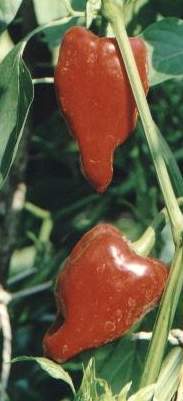
|
| Poblanos are
large-fruited paprikas with a fruity flavour and
a mild, pleasant pungency. |
|
|
|
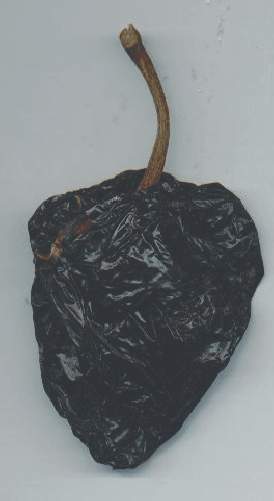
|
| The ancho is a dried
poblano; it plays an eminent rôle in the
cuisines of México. |
|
| |
|
|
|
 The chile
pasilla (also called chile negro) is
one of the most common Mexican chiles
|
| |
|
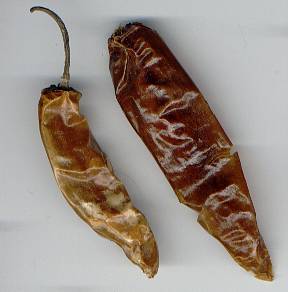
|
| The Mexican costeńo amarillo
chile, dried |
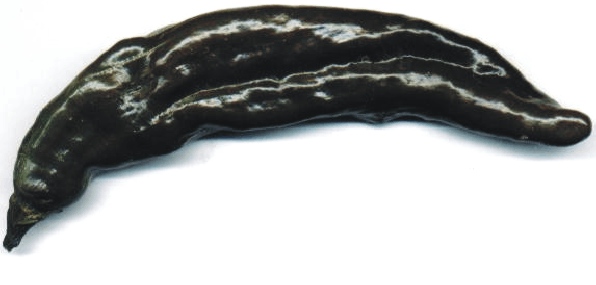
Its fresh form, called chilaca,
is dark green, almost black; it is used much more rarely.
|
Much of the secrets of Mexican cookery lies in the properties
of dried capsicum. Roasting enhances the natural aroma of
paprika, smoking may add new accents and given the multitude of
different cultivars, a Mexican cook has almost unlimited
possibilities to make his choice from. Salsas (see long
coriander) may be made from either fresh or dried capsicum, or
both. For sauces whose preparation involves long simmering
periods, dried capsicums are unanimously preferred. Often, the
dried capsicums are roasted again and rehydrated in hot (but not
boiling) water before usage. This procedure again intensifies the
flavour.
Mild varieties (like ancho, mulato and pasilla,
which are often referred to as "the holy trinity") are
commonly combined with less aromatic, but more pungent cultivars
like the de arbol or the smoky chipotle. The
results are often phantastic.

|
The Mexican pasilla de Oaxaca
chile, dried and smoked
|
| |

|
Dried chile
pulla from México, Perú
|
|
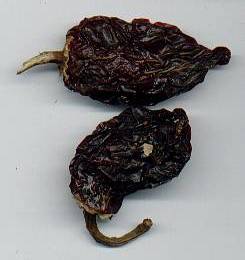
|
The Mexican chipotle chile
is a dried and smoked ripe jalapeńo.
|
|
As ripe chiles cannot easily be stored, the Mexican Indians
have invented a smoking precedure that yields chiles of unique
culinary value. The most common smoked chile, the chipotle,
has become an indispensible ingredient in the cooking style of
the southwestern US (Texas, New Mexico, Arizona), as it provides
a delicious balance of heat and smoky flavour. To use chipotles,
they are normally ground or finely shredded befor usage; an
exception to this rule are chipotles en adobo, which are
whole chipotles stewed in a seasoned tomato sauce. In this
form, the chipotles are used either as a snack or garnish
for those who can stand it, or more commonly as an ingredient to
flavour other foods.
Mexican mole sauces are very complex mixtures of
several different capsicum cultivars plus a large variety of
other ingredients; preparation takes quite a time, in some cases
even days. Most mole call for dried chiles. Oaxaca, a
province in Central México, is regarded the home of these
sauces: In Oaxaca, seven classical recipes (los siete moles)
are traded from generation to generation.
Most moles contain different kinds of nuts and seeds,
which add body, furthermore spices like cinnamon and allspice,
and aromatic vegetables (tomatoes, tomatillos). Corn flour (masa
harina) or dried tortillas are used to thicken. It is
essential to select the proper chiles: For example, mole negro
("black mole") needs the costly and rare chilhuacles
negros, but mole amarillo ("yellow mole") is
prepared with fresh guëros, a more pungent and less
aromatic variety. The most famous recipe is mole rojo
("red mole", also known as mole Poblano); see
sesame for details. For green mole (mole verde), see
Mexican pepper-leaf.
















